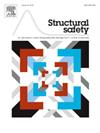Reliability analysis for data-driven noisy models using active learning
IF 6.3
1区 工程技术
Q1 ENGINEERING, CIVIL
引用次数: 0
Abstract
Reliability analysis aims at estimating the failure probability of an engineering system. It often requires multiple runs of a limit-state function, which usually relies on computationally intensive simulations. Traditionally, these simulations have been considered deterministic, i.e. running them multiple times for a given set of input parameters always produces the same output. However, this assumption does not always hold, as many studies in the literature report non-deterministic computational simulations (also known as noisy models). In such cases, running the simulations multiple times with the same input will result in different outputs. Similarly, data-driven models that rely on real-world data may also be affected by noise. This characteristic poses a challenge when performing reliability analysis, as many classical methods, such as FORM and SORM, are tailored to deterministic models. To bridge this gap, this paper provides a novel methodology to perform reliability analysis on models contaminated by noise. In such cases, noise introduces latent uncertainty into the reliability estimator, leading to an incorrect estimation of the real underlying reliability index, even when using Monte Carlo simulation. To overcome this challenge, we propose the use of denoising regression-based surrogate models within an active learning reliability analysis framework. Specifically, we combine Gaussian process regression with a noise-aware learning function to efficiently estimate the probability of failure of the underlying noise-free model. We showcase the effectiveness of this methodology on standard benchmark functions and a finite element model of a realistic structural frame.
基于主动学习的数据驱动噪声模型可靠性分析
可靠性分析的目的是估计工程系统的失效概率。它通常需要多次运行一个极限状态函数,这通常依赖于计算密集型的模拟。传统上,这些模拟被认为是确定性的,即对于给定的一组输入参数多次运行它们总是产生相同的输出。然而,这一假设并不总是成立,因为文献中的许多研究报告了非确定性计算模拟(也称为噪声模型)。在这种情况下,使用相同的输入多次运行模拟将导致不同的输出。同样,依赖于真实世界数据的数据驱动模型也可能受到噪声的影响。这一特性在执行可靠性分析时提出了挑战,因为许多经典方法(如FORM和SORM)都是针对确定性模型量身定制的。为了弥补这一差距,本文提供了一种新的方法来对受噪声污染的模型进行可靠性分析。在这种情况下,噪声将潜在的不确定性引入可靠性估计器,导致对真实潜在可靠性指标的不正确估计,即使使用蒙特卡罗模拟也是如此。为了克服这一挑战,我们建议在主动学习可靠性分析框架中使用基于去噪回归的代理模型。具体来说,我们将高斯过程回归与噪声感知学习函数相结合,以有效地估计底层无噪声模型的失效概率。我们展示了这种方法在标准基准函数和现实结构框架的有限元模型上的有效性。
本文章由计算机程序翻译,如有差异,请以英文原文为准。
求助全文
约1分钟内获得全文
求助全文
来源期刊

Structural Safety
工程技术-工程:土木
CiteScore
11.30
自引率
8.60%
发文量
67
审稿时长
53 days
期刊介绍:
Structural Safety is an international journal devoted to integrated risk assessment for a wide range of constructed facilities such as buildings, bridges, earth structures, offshore facilities, dams, lifelines and nuclear structural systems. Its purpose is to foster communication about risk and reliability among technical disciplines involved in design and construction, and to enhance the use of risk management in the constructed environment
 求助内容:
求助内容: 应助结果提醒方式:
应助结果提醒方式:


